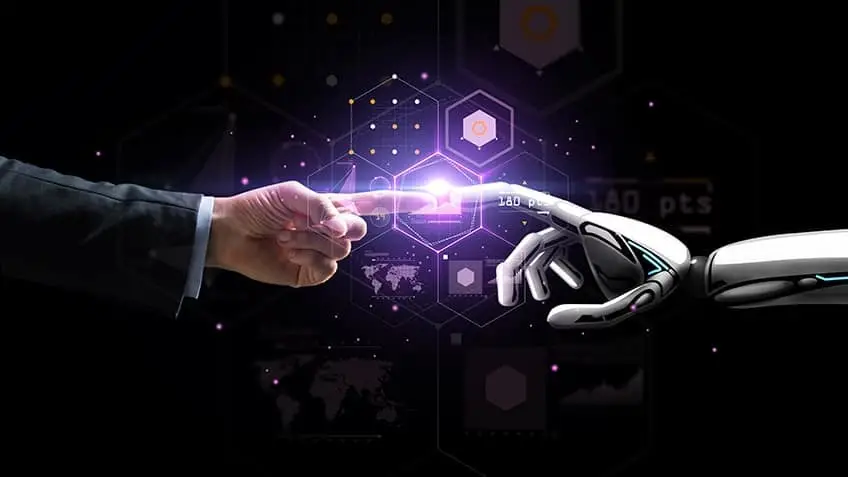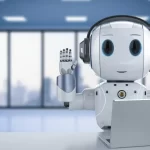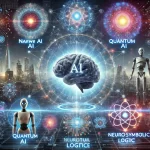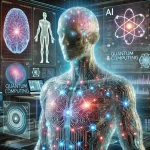
6 Ways to prepare students for an AI future
December 22, 2023Artificial Intelligence (AI) is advancing rapidly, poised to bring significant changes to our world and the workforce. Despite the uncertainties ahead, there are immediate steps we can take to equip students for these transformations. Here are six actionable shifts that can be implemented in classrooms right away.
The growth of AI is remarkable, prompting us to consider its applications in our present context. Questions arise, such as, “How can AI assist in lesson planning?” or “Can it streamline grading processes?” These considerations are crucial for adapting to AI’s current capabilities.
While some focus on the immediate benefits, others are contemplating the long-term implications. Forward-thinking educators are pondering how to prepare students for a future shaped by widespread AI influence, asking questions like, “What can I do today to ready students for a decade from now?” and “Is the knowledge imparted in my class relevant to their future lives?”
Realistically, most educators may not single-handedly enact significant changes at the institutional level. However, the power lies in making incremental adjustments to teaching methods, starting today.
Here are six shifts we can implement in our classes immediately, all aimed at preparing students for an AI-influenced future. Notably, these shifts don’t necessarily involve incorporating more AI directly into the classroom.
Why are these shifts important?
Advancements in AI, exemplified by the rapid release of products like ChatGPT and GPT-4, showcase the breakneck speed of innovation in this field. From introducing “computer vision” to enabling code interpretation, the capabilities of AI are expanding exponentially.
As AI continues to progress, it heralds a transformative shift in the workforce, work processes, and daily life. The emergence of numerous AI-driven tools in a short span underscores the profound impact it will have on various facets of society.
Where are we headed?
Predictions from 2018, before the recent surge in AI development, indicated that AI would outperform humans in many activities within a decade. Projections included AI-driven trucks by 2027, retail roles by 2031, bestselling books authored by AI by 2049, and even AI as surgeons by 2053.
These forecasts, made prior to the current AI boom, highlight the rapid pace of technological advancement. As we surpass predictions like AI translating languages by 2024 and writing high-school essays by 2026, it becomes clear that the workforce our students will enter might undergo drastic changes.
How can we prepare students for this AI future?
Initiating discussions about AI in schools and addressing its implications is crucial. While some districts are formulating policies for responsible AI use, systemic changes are not the only solution.
Even small adjustments in the classroom can play a significant role in preparing students for a future where AI plays a prominent role. It’s about fostering adaptability, critical thinking, and a proactive mindset that aligns with the evolving landscape influenced by AI.
1.Prioritize “Why” Instead of “What”
Conventional teaching often places a disproportionate emphasis on answering the “what” question rather than delving into the “why.” This focus is evident in multiple-choice quizzes, test structures, and comprehension questions found at the end of textbook chapters. In cinematic portrayals, teachers are often seen grappling for answers when posing questions to the class, met with silence and the desperate plea, “Anyone? Anyone?”
While many dedicated educators aspire to go beyond this approach, the prevalence of the “what” remains ingrained in traditional teaching methods. However, a subtle shift towards emphasizing the “why” can yield profound benefits.
Implications: Facts and details, though integral, represent only a fraction of the broader narrative. Often, they lack the instructive power to impart life lessons crucial for future decision-making. Moreover, in an era of readily available information through search engines and AI assistants, the importance of memorizing details diminishes.
Prioritizing the “why” involves extracting valuable lessons, understanding potential life paths, and embracing advice that can guide decision-making. This approach prepares individuals for an AI-dominated future, much like search engines did in the past. As AI assistants facilitate easy access to information, the pertinent question becomes, “What meaningful actions can I take with this information?” AI models can gather, summarize, and prioritize data, leaving the responsibility on individuals to make informed decisions and take proactive steps.
Classroom Prompts:
- Why do you think the characters made that choice?
- How did the outcome impact their lives?
- If you were in their position, what changes would you consider?
- How does this scenario relate to our daily experiences?
- In what ways could this information be relevant to current events in the world?
2. Prioritize the Process over the Product
In many educational settings, grading often revolves around evaluating what students submit, such as worksheets, essays, or math problems. The conventional approach awards points for correct answers, reinforcing the notion that accuracy on the first attempt is paramount.
However, the real world frequently values arriving at the correct answer over time, rather than achieving it immediately. Shifting the focus to process over product encourages students to concentrate on the “why” and the “how,” facilitating the application of these lessons across various aspects of their lives.
Implications: Emphasizing process over product places greater importance on the journey to the final outcome rather than solely on the outcome itself. This approach encourages students and teachers to scrutinize the steps taken and the thought processes involved. Instead of completing an entire math worksheet, a student might choose to thoroughly delve into a single problem, documenting their thought process through video or audio recordings.
Incorporating reflective questions is beneficial in this context. Students can describe their process in follow-up inquiries, compelling them to articulate how they reached their conclusions. Simultaneously, this provides teachers with insights into their students’ thought processes.
How this readies us for an AI future: Similar to the emphasis on “why over what,” the process over product approach directs attention to student thinking. While AI can generate tangible learning artifacts, such as worksheets and essays, humans are uniquely positioned to focus on the intricacies of the process. While AI can assist in problem-solving, human intervention remains indispensable in situations requiring independent action.
Classroom Prompts:
- How did you go about solving that problem?
- Walk me through the steps you took to reach your conclusion.
- Were there any challenging aspects of the process for you?
- How did you overcome any difficulties you encountered?
- If you were to approach this again, what changes would you make?
- What insights did you gain from the process that you would apply in the future?
3. Prioritize Problem-Solving Abilities
Problem-solving comes in various forms, and the process might not be immediately apparent if one hasn’t encountered many complex challenges or reflected on the problem-solving approach. However, the ability to methodically navigate through a problem to find a solution is a skill that remains essential throughout our lives, regardless of the assistance AI can provide.
Implications: Problem-solving extends beyond merely answering questions and doesn’t necessarily require the adoption of a complex problem-based or project-based learning model. It can find a middle ground.
Various approaches exist for solving intricate problems, and an eight-step process can guide this journey:
- Defining the problem
- Clarifying the problem
- Defining the goals
- Identifying the root cause of the problem
- Developing an action plan
- Executing the action plan
- Evaluating the results
- Continuously improving
How this readies us for an AI future: While AI models excel at handling complex problems with diverse information, their problem-solving priorities and values may not always align with human preferences. Additionally, there will be situations where consulting an AI model for solutions may not be feasible, emphasizing the ongoing need for human-driven problem-solving.
Classroom Prompts:
- What is the perceived problem, and can we collectively agree on its definition?
- What are our desired outcomes? What goals are we aiming to achieve?
- Which actions align best with accomplishing our goals?
- How should we implement these actions?
- Do the results indicate successful problem resolution or success in specific areas?
- In what ways could we approach this differently to enhance future outcomes?
4. Discussing the Morality of Actions
Decision-making is inherently intricate. Even when choices appear limited, determining the best option can be a complex task. Decisions often exert varying impacts on different individuals, generating both positive and negative effects. What one group deems as right, another might perceive as wrong.
This is the core of ethics—the philosophical exploration of moral distinctions between right and wrong, good and bad, and the principles governing human conduct. Throughout history, decisions have been evaluated through a moral lens, and ethics play a crucial role in guiding actions across diverse fields of study.
As we pivot from a focus on “what” to “why” (as discussed above), engaging in ethical inquiries enables students to practice decision-making with an emphasis on understanding the rationale behind choices.
How this readies us for an AI future: AI models make decisions based on their training and the data within their datasets. However, the origin of this data and the shaping of their training come from humans, at least for the present. While artificial intelligence continues to integrate into various aspects of our lives, determining the extent and areas of its influence raises ethical questions. It is imperative not to delegate these decisions solely to artificial intelligence, as they profoundly impact our existence and shape our future. By cultivating ethical thinkers in the classroom, students are better equipped to navigate these complex decisions in the evolving landscape of AI.
Classroom Prompts:
- Is this course of action morally sound or objectionable? Why?
- Who perceives this action positively, and who views it negatively? Why?
- Which individuals would be most affected by this decision, and in what ways, positively or negatively?
- What or who is influencing the decision-making process, and in what manner?
- What are the immediate and long-term consequences of these actions?
5. Promoting Effective Learning Strategies
Throughout their educational journeys, students engage in various learning activities, yet rarely do they delve into the science of learning—understanding the intricacies of brain function, cognitive processes, and ways to enhance learning outcomes. While dedicated educators make conscious decisions to facilitate effective learning, equipping students with an understanding of how their brains operate optimally empowers them to navigate any challenges in their future.
What this entails: Cognitive science has explored the intricacies of brain function, information processing, and skill improvement for decades. While memory remains a critical focus, broader aspects of learning gain significance. The Derek Bok Center for Teaching and Learning at Harvard University identifies key areas in the science of learning:
- Understanding memory processes
- Comprehending and communicating knowledge
- Metacognition and motivation
- Promoting engagement
How this readies us for an AI future: The evolving landscape shaped by widespread AI integration brings uncertainty about changes in the workforce. Some jobs may become obsolete, while new roles emerge. In preparing for this dynamic future, the ability to learn effectively becomes paramount. While AI models may possess superior intellect, the capacity to learn, make decisions, and solve problems remains a uniquely human strength. Being agile learners positions individuals advantageously in an ever-changing AI-driven world.
Classroom Prompts:
- How can we gain a clearer understanding of this concept?
- What methods work best for your learning style?
- What does research indicate as effective learning strategies?
- Under what conditions do you find yourself learning most effectively?
6. Highlighting the Importance of Collaboration and Relationships
Both in professional and personal spheres, collaboration and relationships have long been the driving forces in our interconnected world. People remain at the heart of societal dynamics, a principle consistently emphasized by companies. The 2023 NACE Job Outlook survey underscores the significance of collaboration, ranking “ability to work in a team” as the second most sought-after attribute on candidates’ resumes. Sixty-one percent of survey respondents deemed this ability as very important or extremely important, second only to problem-solving skills (refer to point No. 3 above).
Collaboration and relationship-building not only serve as motivational factors in students’ current endeavors but also equip them for the evolving landscape of future work, regardless of its nature or structure.
What this entails: True collaboration entails students working collectively, leveraging each other’s unique skills to reach conclusions or produce outcomes that wouldn’t be attainable without the combined efforts of all participants. Even if the pinnacle of collaboration isn’t always reached, the process fosters an understanding of diverse viewpoints, facilitates effective problem-solving, and enables students to achieve more collectively than they might individually.
Developing relationship-building skills is crucial preparation for the future. Regardless of the shape our future work takes, human interactions will remain essential. Humans will continue to depend on each other, and the ability to build relationships—particularly in the context of collaborative work—becomes a pivotal skill.
How this readies us for an AI future: While the rise of AI will reshape the nature of work, human existence will endure. Even as AI assumes certain tasks and cognitive functions, humans will still contribute meaningful work and seek purpose. Human-to-human interaction will remain a fundamental need. The timeless skill of working together and fostering positive relationships is invaluable, transcending technological changes.
Classroom Prompts:
- Reflect on the distribution of work in this project and share your thoughts.
- Identify the skills and abilities you brought to the project.
- Assess whether your strengths were optimally utilized in this project and suggest potential changes.
- Discuss any confrontations or disagreements that arose and how they were addressed.
- Propose steps to set up successful interactions with your teammates in future projects.

















